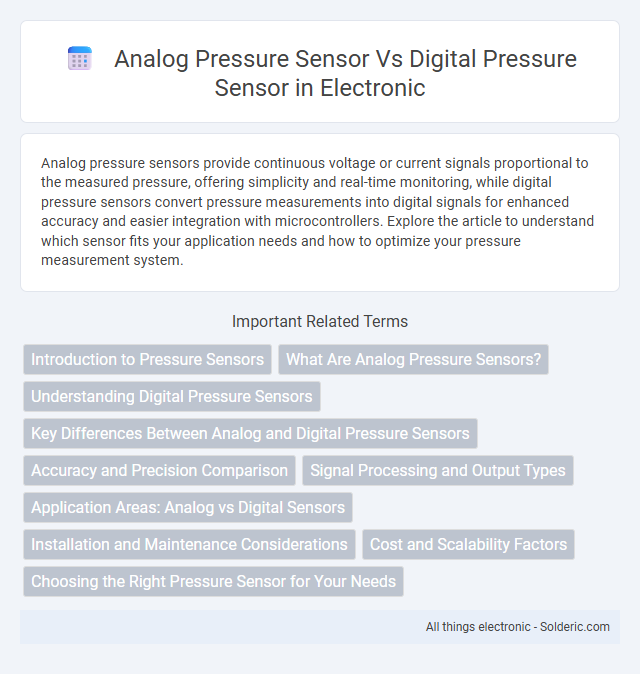Analog pressure sensors provide continuous voltage or current signals proportional to the measured pressure, offering simplicity and real-time monitoring, while digital pressure sensors convert pressure measurements into digital signals for enhanced accuracy and easier integration with microcontrollers. Explore the article to understand which sensor fits your application needs and how to optimize your pressure measurement system.
Comparison Table
| Feature | Analog Pressure Sensor | Digital Pressure Sensor |
|---|---|---|
| Output Type | Continuous analog voltage or current | Discrete digital signal (I2C, SPI, UART) |
| Accuracy | Moderate, susceptible to noise | High, less noise interference |
| Signal Processing | Requires external ADC and filtering | Integrated ADC and processing |
| Complexity | Simple, cost-effective | More complex, higher cost |
| Calibration | Manual calibration needed | Factory calibrated with digital compensation |
| Noise Immunity | Low, analog signals affected by interference | High, digital signals less affected |
| Output Range | Continuous variable | Fixed resolution, defined by bit-length |
| Interface Requirements | Analog input on microcontrollers or DAQ | Digital communication protocol support required |
| Power Consumption | Generally low | Higher due to integrated electronics |
| Applications | Simple sensing, cost-sensitive projects | Precision measurement, industrial automation |
Introduction to Pressure Sensors
Pressure sensors detect and measure pressure changes in gases or liquids, converting physical pressure into electrical signals for monitoring and control systems. Analog pressure sensors provide a continuous voltage or current output proportional to the pressure, suitable for applications requiring real-time, variable data. Digital pressure sensors offer discrete, digitized output with built-in signal processing, enhancing accuracy and ease of integration in modern electronic devices.
What Are Analog Pressure Sensors?
Analog pressure sensors convert physical pressure into continuous voltage or current signals that vary proportionally with the applied pressure, enabling real-time monitoring and precise measurement. Your system interprets these continuous analog signals through an analog-to-digital converter (ADC) to analyze pressure changes seamlessly. Common applications include industrial process control, automotive systems, and HVAC monitoring where smooth, varying pressure data is crucial.
Understanding Digital Pressure Sensors
Digital pressure sensors provide precise pressure measurements through integrated microprocessors that convert analog signals into digital outputs, enhancing accuracy and ease of integration with modern electronic systems. Unlike analog pressure sensors, which produce continuous voltage or current signals proportional to pressure, digital sensors deliver discrete data, minimizing signal interference and enabling direct communication with microcontrollers or digital displays. This advanced functionality supports real-time monitoring, data processing, and improved diagnostic capabilities in applications such as industrial automation, automotive systems, and consumer electronics.
Key Differences Between Analog and Digital Pressure Sensors
Analog pressure sensors provide a continuous voltage or current output proportional to the pressure, allowing real-time monitoring with high resolution. Digital pressure sensors convert the pressure signal into a digital output, offering improved noise immunity, easier integration with microcontrollers, and precise digital communication protocols. Your choice depends on the need for direct sensor readings versus advanced data processing and noise resistance in pressure measurement applications.
Accuracy and Precision Comparison
Analog pressure sensors provide continuous output signals, allowing for smooth and high-resolution measurements, which can enhance precision in detecting subtle pressure variations. Digital pressure sensors, however, offer improved accuracy through integrated signal processing and calibration, minimizing noise and signal degradation. Your choice depends on whether you prioritize fine-grained measurement resolution (analog) or consistent, calibrated accuracy with digital output.
Signal Processing and Output Types
Analog pressure sensors produce continuous voltage or current signals proportional to the pressure, requiring external signal conditioning and analog-to-digital conversion for digital systems. Digital pressure sensors integrate signal processing internally, offering standardized digital outputs such as I2C, SPI, or UART, which simplify interface and enhance noise immunity. The choice depends on application requirements for precision, integration complexity, and real-time data processing.
Application Areas: Analog vs Digital Sensors
Analog pressure sensors are widely used in applications requiring continuous real-time monitoring, such as HVAC systems, industrial automation, and automotive fuel systems, due to their straightforward signal output and compatibility with legacy control systems. Digital pressure sensors excel in environments demanding precise data accuracy, calibration ease, and integration with advanced microcontroller-based systems, often found in medical devices, aerospace instrumentation, and smart home technology. Your choice between analog and digital pressure sensors should consider factors like signal processing requirements, noise immunity, and data communication protocols tailored to the specific application area.
Installation and Maintenance Considerations
Analog pressure sensors require careful calibration during installation to ensure accurate output signals proportional to pressure changes, and they may need periodic recalibration to maintain precision. Digital pressure sensors often feature simplified installation with plug-and-play interfaces and built-in diagnostics, reducing the need for frequent maintenance. Maintenance for digital sensors is generally lower due to integrated signal processing and error correction capabilities, enhancing reliability in demanding environments.
Cost and Scalability Factors
Analog pressure sensors typically offer lower initial costs and simpler integration, making them suitable for budget-conscious projects. Digital pressure sensors provide enhanced scalability through easy interfacing with microcontrollers and advanced data processing capabilities, which can justify their higher price in complex applications. You should consider the trade-off between upfront investment and the potential for future upgrades when choosing between these sensor types.
Choosing the Right Pressure Sensor for Your Needs
Selecting the right pressure sensor depends on application accuracy, signal processing, and integration requirements. Analog pressure sensors provide continuous voltage or current output ideal for real-time monitoring and fine-tuned control, while digital pressure sensors offer precision measurement with built-in analog-to-digital conversion, enhancing noise immunity and simplifying data communication. Consider factors like required resolution, interface compatibility, environmental conditions, and system complexity to determine whether an analog or digital pressure sensor best suits your industrial or commercial application.
Analog pressure sensor vs digital pressure sensor Infographic

 solderic.com
solderic.com